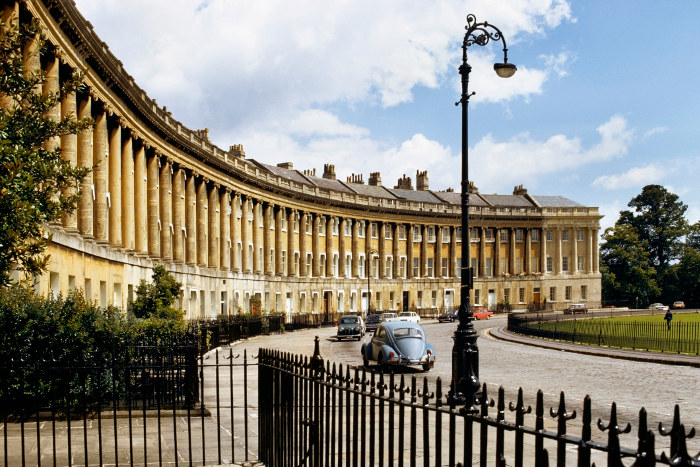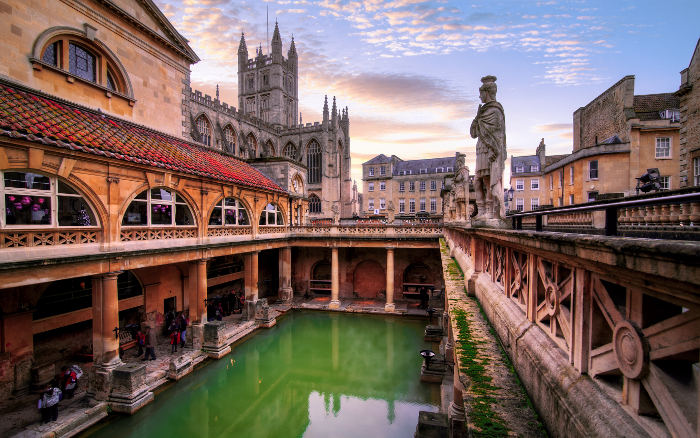Framed by the rolling green hills of Somerset, a 90-minute train ride west of London, Bath is one of England’s most alluring city breaks. Charmingly picturesque, this UNESCO World Heritage site has bundles of things to see and do, and plenty of traditional and trendy places in which to refuel on delicious food and drink. Here are the highlights of a Bath visit.
Roman Baths And Spas
Bath famously nestles on a network of hot springs, which are believed to have been discovered by Celtic tribes around 100BC, then mastered by the spa-loving Romans a century or so later. At the majestically preserved Roman Baths, you can delve into the past, admiring ornate columns, statues and even a ‘hidden’ Roman temple, while walking beside the complex’s steaming bathing pool. You can’t bathe here any more, but you can taste the mineral-rich, sulphur-tinged waters from a fountain, while various Bath spas invite you to don your Speedos and swimsuits and relax in natural thermal waters (heated at around 35-40C). Try the Thermae Bath Spa, a sleek option with a rooftop pool lording over Bath’s historic centre. It’s across the road from the Gainsborough Bath Spa, which is lauded for its luxurious aqua therapy treatments.
 The Royal Crescent is Bath’s most famous Georgian street.
The Royal Crescent is Bath’s most famous Georgian street.Georgian Gems
Much of Bath’s richly photogenic, honey-stone architecture dates from the Georgian period (the 18th and early 19th centuries), when the city’s ancient spa culture was revived and well-to-do types, including Queen Anne, and artists like Thomas Gainsborough, flocked here to “take the waters”. As Bath became more fashionable, grand streets and buildings sprung up, designed by celebrated architects like Robert Adam and John Wood, the Elder (and his son, John Wood, the Younger). Don’t miss the Royal Crescent, a sweeping neo-classical curve of terraced townhouses, and the Pulteney Bridge, which spans the River Avon and evokes Florence’s Ponte Vecchio with its neat shops and eateries overlooking the water.
Literary Links
Another notable visitor during Bath’s golden Georgian era was Jane Austen. The author lived in Bath from 1801 and 1806, setting two of her novels (Northanger Abbey and Persuasion), here, and her legacy is celebrated in the Jane Austen Centre, a cute museum oozing period detail and numerous images of Mr Darcy (or at least Colin Firth dressed as Mr Darcy). Every September, revellers do their best Darcy and Elizabeth Bennet impressions during the Jane Austen Festival, a high-spirited feast of bonnets and balls. On John Street, one of the backstreets behind the Jane Austen Centre, you’ll find Mr B’s Emporium Of Reading Delights. Along with Topping & Company Booksellers, off Broad Street, it’s a magnet for Bath’s bookworms.
Deli’s, Bars And Gastropubs
You can sip ‘Gin Austen’ cocktails, made with Bath Gin, at the Canary Gin Bar, a snug establishment on cobbled Queen Street and one of the pioneers of Bath’s thriving home-grown food and drink scene. If you’d prefer a local beer, try Bath Brew House, which serves in-house microbrews (including two signature ales, Emperor and Gladiator). After something fruity? The Stable has around 80 different ciders, many from local producers (they go well with the pizzas and pies here).
The menus at Bath’s leading gastropubs and restaurants change with the seasons, with ingredients sourced from the surrounding, pastoral West Country. Established in 1776, the Chequers is renowned for its Sunday roasts and inventive multi-course affairs. For a flavour of Bath’s culinary offerings, Savouring Bath’s tours take in artisanal delis, bakeries, cafes and farmers’ markets.
Tea, Coffee And Cake
Bath is sprinkled with dainty tea rooms like Sally Lunn’s, which is tucked down a narrow, atmospheric passageway near the medieval Bath Abbey. Occupying one of Bath’s oldest standing houses from the 1400s, it serves cream teas with a local delicacy – the Sally Lunn bun. Coming in sweet and savoury flavours, this part-cake, part-bread, part-bun is named after the French Huguenot refugee who opened a bakery in Bath in the 17th century. You can get a decent flat white from several Bath cafes, including Colonna and Small’s, which is co-owned by Maxwell Colonna-Dashwood, a two-time former UK barista champion who cultivated his coffee-making skills while living in Melbourne.

